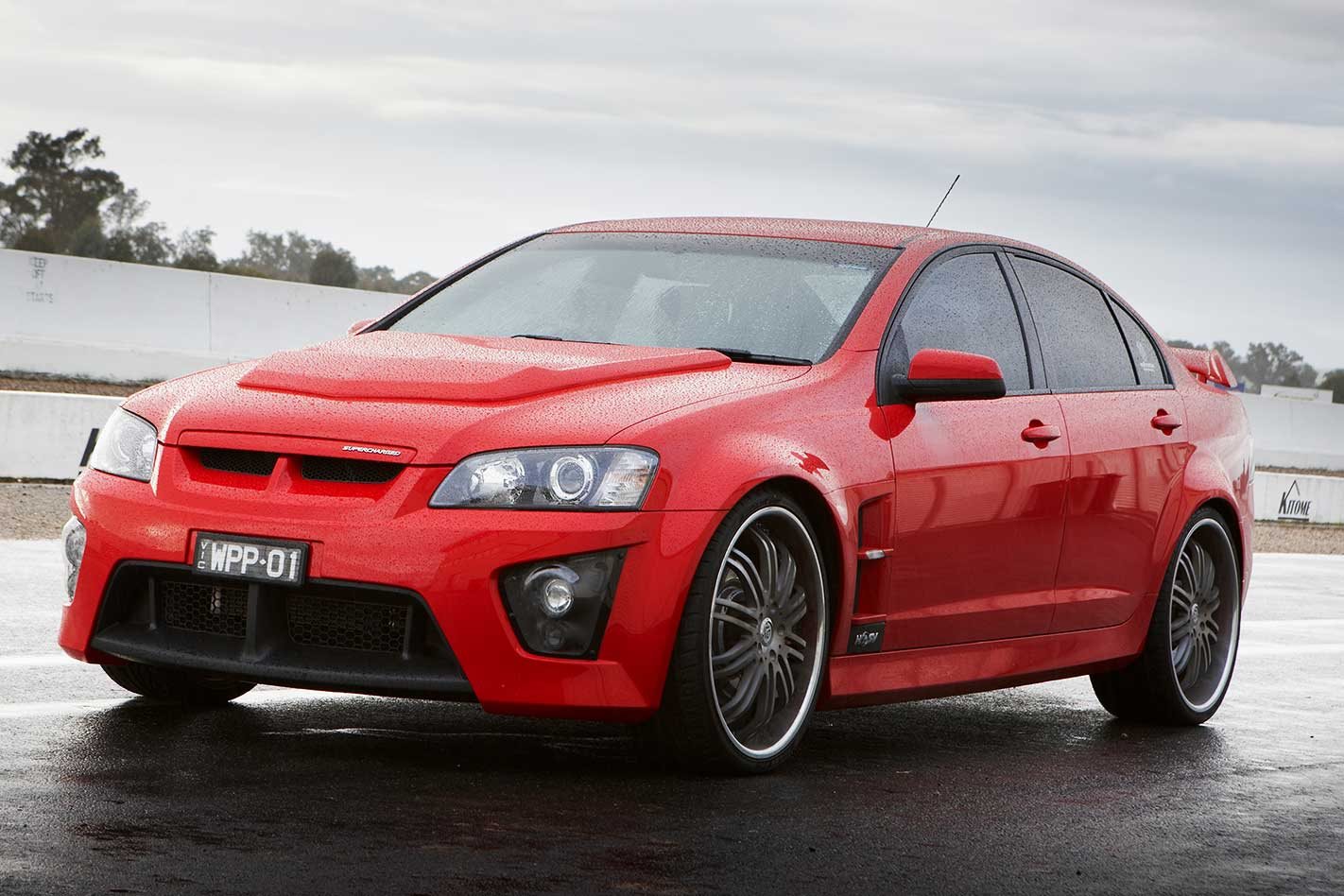Four hundred and seventy kilowatts. That’s a figure so formidable, mere numerals don’t do it justice. Here’s another worth spelling out: seven hundred and eighty Newton metres.
This review was originally published in MOTOR’s September 2008 issue
Who on Earth throws around such numbers? Massey Ferguson? Kenworth? The Royal Australian Air Force? Even for Lamborghini that’s impressive. But when they apply to a humble HSV VE Clubsport, you know you’re pushing the envelope like a coked-up postman.
Most casual gawkers during our test presume it’s some new whiz-bang model in Clayton’s line-up. Nope. On day-release from Walkinshaw Performance’s Braeside headquarters, in Melbourne’s suburbia, this Clubby comes bellowing and screaming across the ever-changing Aussie muscle-car landscape like a red exclamation mark. Not just figuratively, but literally.
On a quiet morning, you can hear it coming long before you see it. And it’s not its guttural exhaust note — imagine a V8 Supercar engine gargling rocks — piercing the air, but the cat-in-a-blender shriek of a supercharger. It’s like motoring’s classic rock at full noise, and a sonic giveaway to anyone with a passing interest in horsepower hedonism.
“No, officer, it didn’t come like this from the factory.”
And yet, in many ways, it’s bloody close. WP is renowned for creating OE factory-style engineering and presentation. With WP and HSV kissing cousins under Tom Walkinshaw’s corporate umbrella, you’d expect as much, too.
No wonder punters get duped, despite WP’s effort in crafting a unique identity for its cars. HSV badges are removed, there’s no ‘470’ horsepower boast on the bootlid, and it’s littered with WP logos. As a one-off rolling demo of WP’s VE-ready aftermarket goodies — and not a turn-key showroom model — it has no name. Of course, ‘No Name’ looks ridiculous in print, so we’ll call it the ‘WP470’. No worries. You’re welcome.
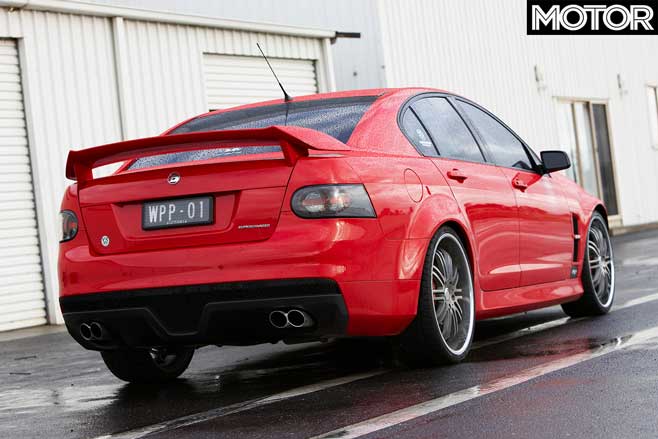
Yes, it’s a bit of politicking. HSV’s record-breaking 375kW, 640Nm, $155K W427 blockbuster’s arrived (see p.38) and any head-banging Über-Dore seen to undercut Mr Tall Poppy by 100kW and 130Nm can make things, er, awkward. Especially as the WP470, as tested, costs a smidge under 100 grand…
WP’s Gary Beer keenly downplays comparisons: “If you want cohesive, all-round OE greatness, the red Clubby can’t touch the W427. But if you want your head ripped off…”
Achieving the staggering 470kW and 770Nm figures was straightforward enough. WP applied its proven 6.0-litre LS2 supercharger tech — a potent 420kW/730Nm package to begin with — to HSV’s new 6.2-litre LS3.
A few things were revised, such as the nifty inlet manifold/water-to-air intercooler and exhaust system, and blower-specific ECU flash reprogramming. But the guts of it is that WP’s existing, and unique, Harrop-made ’charger was overdriven to match the deeper-breathing (bigger bores, freer-flowing heads, larger cam, et al) Chev V8.
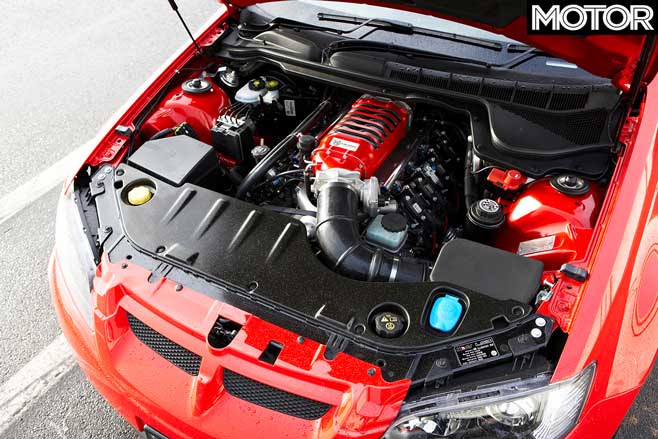
Thanks to its tricky bypass valving system, boost ramps upwards from zero pressure at idle to about 0.6bar (8.6psi) at redline. That’s a fair bit considering the LS3’s 10.7:1 compression, yet it feels like the engine isn’t breaking a sweat in churning out 40 percent more power.
The whole supercharger set-up ($15,500, plus $2100 for the exhaust) is simple, neat and compact – proof that when it comes to giving the LS3 hornet’s nest a proper smashing, belt-driven forced induction is hard to beat.
It adds little in the way of size, weight and complexity to the engine bay, and is very discrete. The cost of elaborate custom-made turbocharging isn’t nearly as practical if poking HSV’s all-alloy V8 bear is your idea of fun.
And, lord, it growls like a grizzly once you fire it up. No silken sheen here. It’s all animalistic brooding at idle, it’s gruff down low, and it pops and crackles on the overrun. But it’s the blower howl through the firewall that curdles your blood.
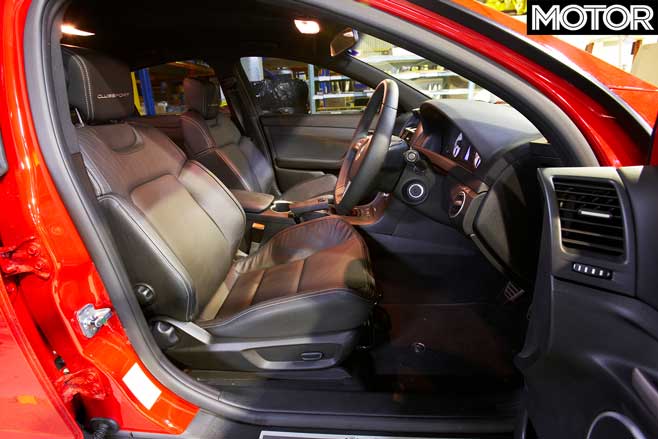
You reasonably expect tyre-shredding, light-switch dynamite. But instead, it carves a chunk of planet-shifting energy and places it, with instant and accurate control, under your right foot. It’s benignly flexible at low rpm and sort of masks the near-800Nm (nudge, wink) avalanche of torque on tap.
On paper, the torque curve is more BMX track than kitchen benchtop, but in practice it’s a smooth, tantrum-free warp drive that seems to magically shed half-a-tonne of the Clubby’s porky 1842kg mass.
You simply dial up the energy, using the loud pedal like the volume knob for a rock concert sound system. With over 760Nm available between 2750 and 5500rpm (the official peak is at 4500rpm), it’s just planted, histrionics-free acceleration until the redline looms and the rears threaten to paint strips on the hot mix.
In third gear. Or, if you’re keen, fourth. The last thing I drove that shimmies its bum with hard-pinning, full-grip theatrics is Porsche’s 911 GT2. It demands respect. Frying the rears in the top of fourth, in a four-door sedan road car, is a fairly new phenomena for mankind. What the tail end might do as a result is about as random as next week’s Lotto result. I’ve heard horror stories…
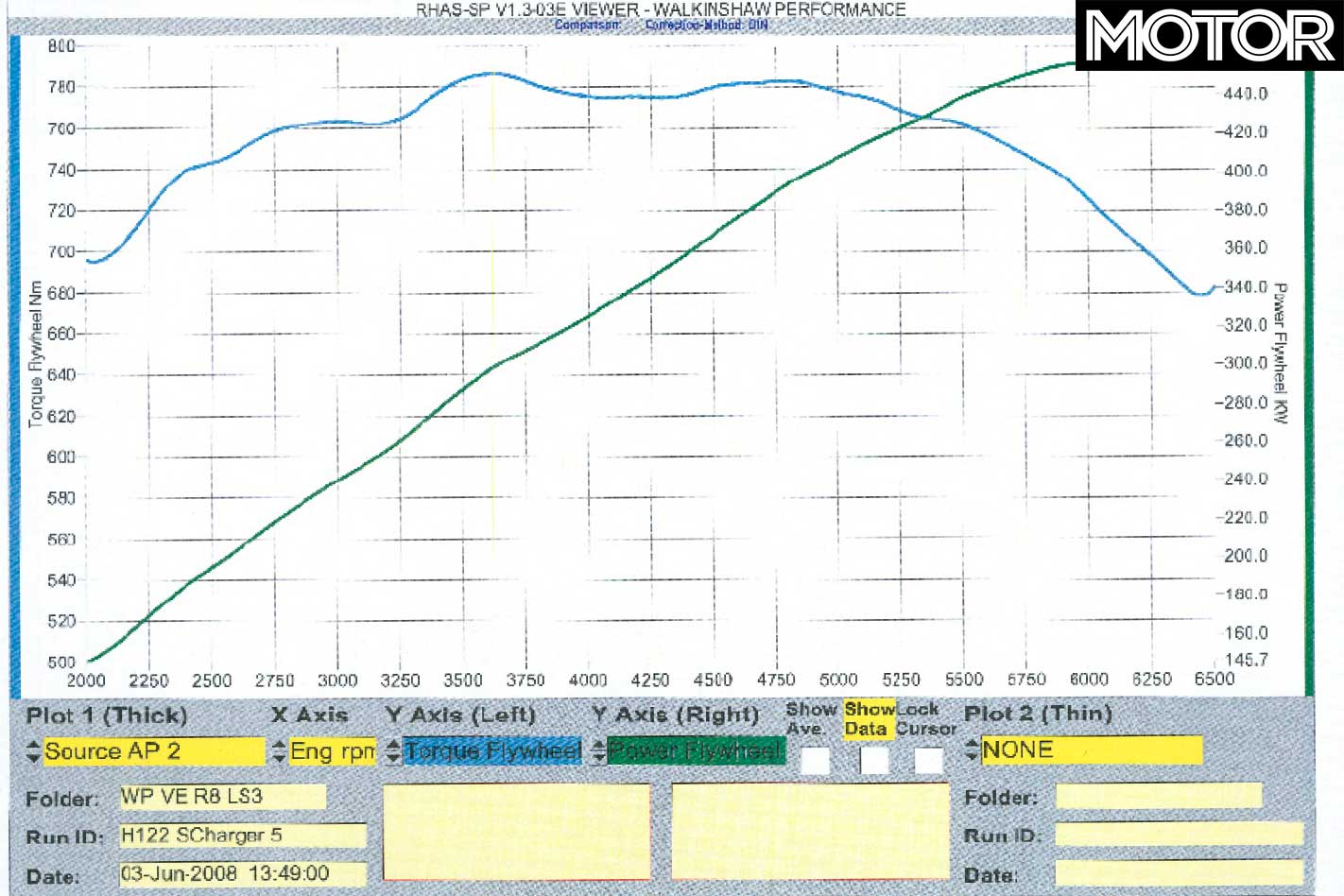
Another thing is reliability. ‘Standard’ pretty much sums up the rest of the driveline. There’s an LS7-spec single-plate-type clutch upgrade, which is light, progressive in take up and works like a dream. It’s mated to the regular Clubby six-cog manual — not the stronger TR6060 unit used in the Z06 ’Vette and HSV W427 — which is unusually slick-shifting and has clocked 5000 faultless kays behind the blown LS3 without drama.
And it’s not like WP’s demo-cum-development car has been mollycoddled with a Grandpa’s slipper treatment. Forget running an auto, though, unless you fancy blending the 6L80 six-speed’s innards into oily chow mein — it’s not rated to cop anywhere near this much torque, and won’t.
WP warns that all-round durability is largely down to the end user. It’s that kind of road car, and not a race car, and yet exploring its limits is sensibly best reserved for the race circuit.
While 470kW plus 770Nm makes for impressive maths, multiplying the result by a number slightly higher than zero — the grip available after a serious bucketing of rain — taunts some eye-opening physics.
Needless to say, proceedings could go pear-shaped to a degree that’d keep the near-by Ardmona fruit factory in business for years. So forget meaningful lap times. And if the world needed another crappy reality TV show (it doesn’t), you could’ve filmed Survivor: Winton on the spot. Rest assured that there were helmets hung over some pretty grim faces.
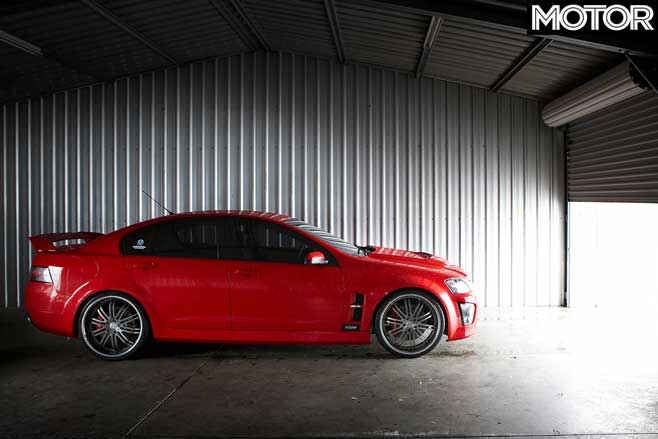
An hour later, though, Amac, V8 Supercar driver Nathan Pretty and I were alive and all smiles in the soggy pitlane, like mates who’ve just exited an amusement-park ride. Each has given the beast a thorough workout, including an impromptu drift session to appease shooter Suesse. And no one had so much as spun the WP470.
While the standard Clubby lacks the sharpness of top-shelf V8 German rivals (C63 AMG, M3, et al), it’s a world-class stunner for mid-corner poise and balance. We’ve said so for ages, so no surprises there.
And it’s not until you pump really stupid output, such as WP470’s, through the rear that you realise how much of a pat on the back HSV — and Holden — engineers deserve. Bar obviously demanding more restraint on the loud pedal, the WP beast knuckles down and links the curves with the predictability and corner-exit drive of the regular Clubby. Power and handling meld together in a unison of easy-to-use linearity. Whether you’re massaging racing lines or dialling up hellacious powerslide angles, it’s child’s play.
Get impatient on the straights and it bangs against the rev-limiter in any gear, but there’s plenty of drive on tap — it’d kill the stock Clubby in wet (or dry, of course) rolling acceleration — and the rear remains tidy, never suddenly snapping sideways and sending you off for a rendezvous with concrete. And that’s the key. The WP470’s greatness is not how much power it makes, but how useable it is to the non-professional driver buying into the experience.
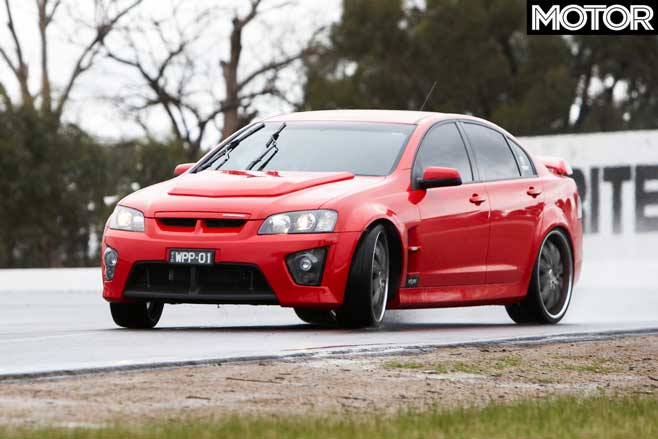
One curious side effect is that the extra torque seems to loosen the reins on the stability control; you get more wheelspin and an extra margin of oversteer angle before the electronic fun police shut the party down. All good, though. That you can milk some extra power-down in the corners without removing the safety net is a major plus.
Letting the team down are those satellite dishes rolled through tar that WP call wheels and tyres. True, the 22-inch Vendetta rims look a million bucks — at $10,950, with tyres, they ain’t far off it — and might prompt a visit to your local roads authority outlet with a hockey mask and ice pick should one crash through a pot hole.
Given WP’s 30mm-lowered suspension kit ($690), the ride comfort is exceptionally compliant. And despite making HSV’s normally butch stopping package — which feels amply capable of compensating for the power hike — look puny, it’s a case of so-far, all-good.
But the painted-on Falken ZR rubber — 30-series fronts and ridiculous 25-series rears — offer no sideways flex or ‘give’ and don’t offer enough in the way of lateral grip. And it’s not just the rear dancing about like Todd McKenney after a night out. Despite some added steering sharpness, it just ploughs on with understeer when pushed.
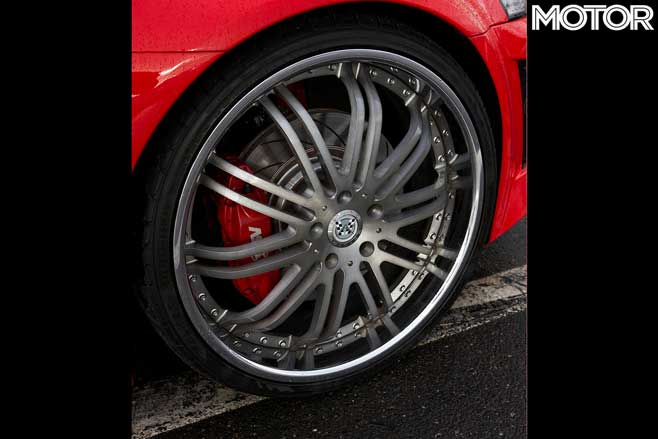
While the Clubby’s mass seems to disappear along the straight stuff, it hasn’t in the curves. In the wet, the WP470 demands concentrated guidance, and once she gets away, it takes some effort to reel it back in. Hot tip: if you tick the box for the 22s, retain the stock 20-inch rim’n’rubber for the weekend warrior — they’re a far more capable combination.
Longitudinal grip, though, isn’t such an issue. Mother Nature stopped whizzing on the parade long enough for the 285mm rears to grip up, the WP470 rattling off a 4.24sec 0-100 stunner and a formidable 12.53sec 0-400m sprint.
Output and time-slip bragging rights is one thing. And a sizeable thing at that. But relating to the WP470 purely in terms of numbers is to miss much of the point of the vehicle. Or any car. And that’s self-expression.
You might think the rims are too ‘gangsta’, or that the non-functional $1850 bonnet blemish isn’t exactly tasteful (hey, don’t let my opinion stop you…), but the WP makeover does say that the car’s owner doesn’t lack for imagination.
It suggests that you love Aussie muscle and that you’re serious about horsepower, but you’re not the stereotypical hoon. It’s a bit ‘outside the box’ and somewhat under the radar — stigma-free petrolhead indulgence.
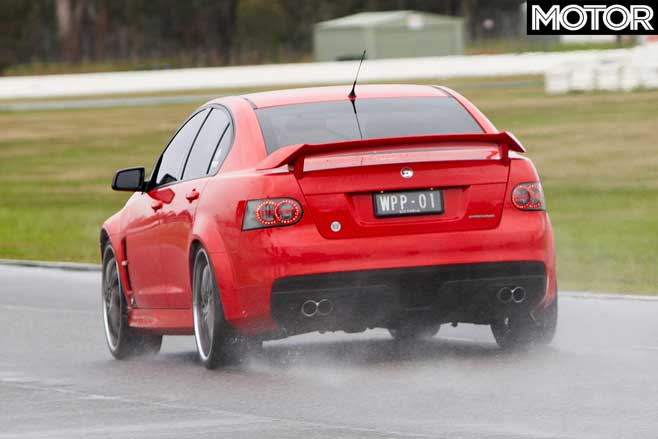
The WP470 might never officially qualify as “the quickest Aussie” of anything, but name anything from anywhere that can come close to offering 470kW and 770Nm for less than six figures ($97,610, to be exact)? Didn’t think so.
It’s ballsy without being ostentatious, and demands maturity and respect from the end user. There are a few hoops to jump through — warranty to name one — and, thus, it demands enthusiast-level commitment. In turn, it rewards with the sort of mettle and character you can’t buy off the shelf. It’s such a real car that, well, it’ll never be a real production car. But don’t let that stop you.

FAST FACTS 2008 Walkinshaw WP470 Clubsport R8 BODY: 4-door, 5-seat sedan DRIVE: rear-wheel ENGINE: 6162cc V8, OHV, 16v BORE/STROKE: 103.25 x 92.0mm COMPRESSION: 10.7:1 POWER: 470kW @ 6500rpm TORQUE: 770Nm @ 4500rpm WEIGHT: 1842kg POWER-TO- WEIGHT: 255kW/tonne TRANSMISSION: 6-speed manual SUSPENSION: struts, A-arms, anti-roll bar (f); multi-links, coil springs, anti-roll bar (r) L/W/h: 4943/1899/1468mm WHEELBASE: 2915mm TRACKS: 1592/1590mm (f/r) STEERING: power rack-and-pinion BRAKES: 365mm ventilated discs, four-piston calipers (f); 350mm ventilated discs, four-piston calipers (r) TYRES: Falken ZR22; 245/30R22 (f), 285/25R22 (r) PRICE: $97,160
PROS: Hilarious outputs at a bargain price, drivability, individuality CONS: 22s compromise ride and grip, noisy blower, no auto option RATING: 4 out of 5 stars
Walkinshaw’s price of power
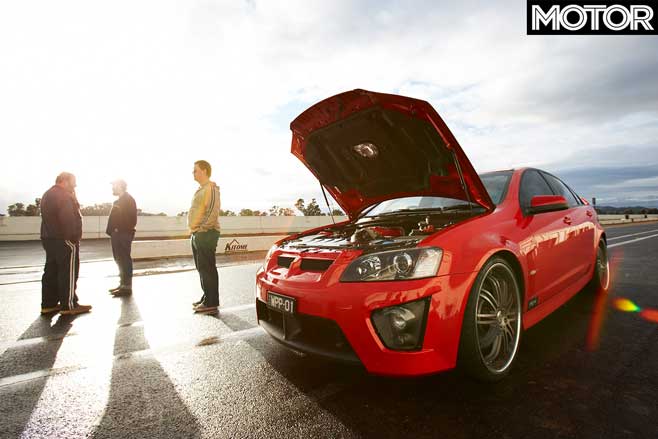
The WPP 122 Supercharger LS3 Kit ($15,500) is very compact, adding marginally more height (it clears the bonnet, just), mass (bugger all) and just one ancillary to the engine bay – a small coolant reservoir.
The inlet manifold is genius. The water-to-air intercooler cores are located inside the manifold and the reverse-mounted blower (snout towards the firewall) driveshaft threads through the manifold’s centre. Very neat, very cool.
With no structural modification required, it’s an easy conversion back to standard LS3-spec.
Add exhaust ($2100), LS7 clutch ($1200), R8-spec suspension ($690), wheels and tyres ($10,950), bonnet scoop ($1850), foggie covers ($160) and sill plates ($160) and the package, as tested, costs $32,610 including GST. It’s a five-day, drive-in and drive-out deal. Noice.
The Strip
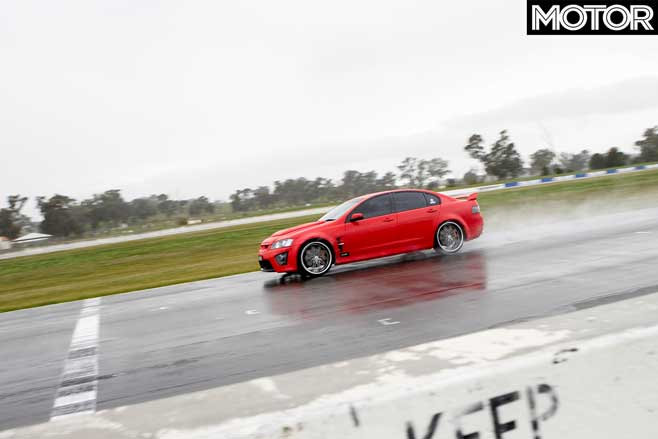
| Walkinshaw WP470 Clubsport R8 | |
| 0-10km/h | 0.39sec |
| 0-20km/h | 0.81sec |
| 0-30km/h | 1.21sec |
| 0-40km/h | 1.61sec |
| 0-50km/h | 2.04sec |
| 0-60km/h | 2.41sec |
| 0-70km/h | 2.79sec |
| 0-80km/h | 3.45sec |
| 0-90km/h | 3.84sec |
| 0-100km/h | 4.24sec |
| 0-110km/h | 5.28sec |
| 0-120km/h | 5.95sec |
| 0-130km/h | 6.68sec |
| 0-140km/h | 7.33sec |
| 0-150km/h | 8.38sec |
| 0-160km/h | 9.30sec |
| 0-170km/h | 10.28sec |
| 0-180km/h | 11.24sec |
| 0-190km/h | 12.26sec |
| 0-400m | 12.53sec @ 192.71km/h |
Walkinshaw WP470 vs Lamborghini Murcielago LP640
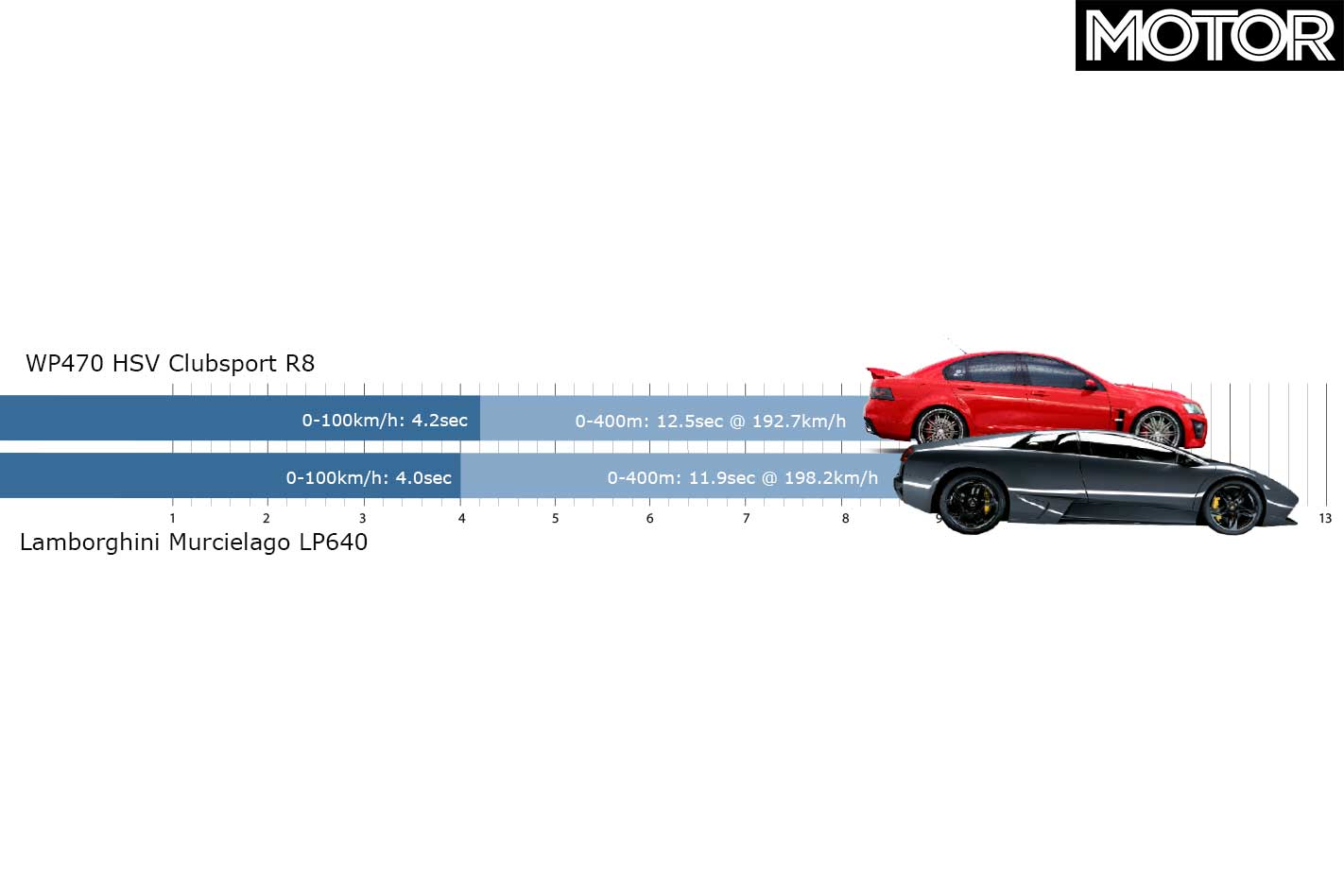
Which brand-spanking turn-key cars on offer in Oz has WP470-like stonk? The $476K CL65 AMG (450kW/1000Nm), $375K Bentley Continental GT (411kW/650Nm) or $595K Ferrari 599 GTB (456kW/608Nm) perhaps? They all come up a bit short. Laughable, innit? But how about a Lambo Murcielago LP640?
Here’s the theoretical shootout. The Lambo offers one extra kilowatt (471kW) from its 6.5-litre V12. But, with 660Nm, it’s shy by 110Nm. But the LP is lighter — 1665kg verses 1842kg — which suggests a bloody close-run race.
Sure enough, it is. During last year’s PCOTY Round Two, the all-paw Lambo nailed a 4.0sec 0-100 time and scorched to the 400m mark in 11.9sec. Meanwhile, the rear-drive WP470 is just 0.2sec slower to 100 kays and a mere 0.6sec shy for the quarter, their terminal speeds split by just 5.5km/h. Sobering?
There’s more. The Murcie demands $675,678, plus some frightening on-road costs. For that money you could buy a WP470 ($100K) and park a Gallardo ($415K) next to it, and have enough change to park an HSV W427 ($155K) in storage as a so-called ‘investment’ to help put the grandkids through uni.


